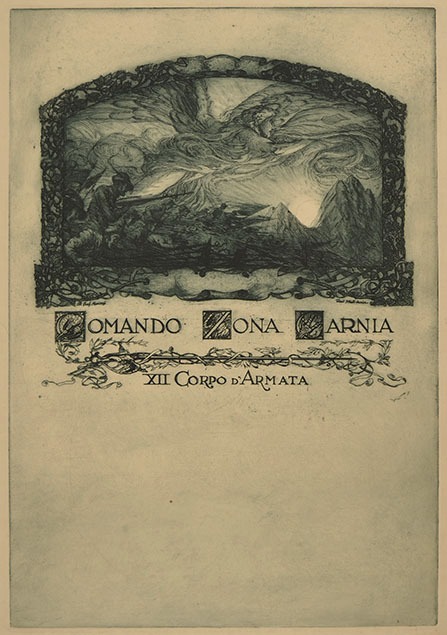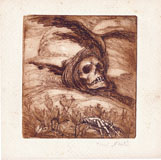(Florence 1886 - Treviso 1917)
COMANDO ZONA CARNIA XII CORPO D'ARMATA , 1916-17
Etching, 1916/17. An extremely fine impression in greenish ink, richly inked and printed with tone on strong wove paper. As stated in the plate, the print was etched by Pieri-Nerli and printed by the Officine Grafiche Marioni. Certainly the etching was conceived to be used during the First World War, in the period of the battles between the Italian army and the Austro-Hungarian and German divisions in the years 1917-1918. Mario Pieri-Nerli died in those battles at the end of 1917. To the platemark 490 x 339 mm, the entire sheet measuring 555 x 393 mm. In very good condition.
In the catalogue of the exhibition devoted to Pieri-Nerli another impression is reproduced. See F. Cagianelli, M. Ratti, F. Sborgi, Mario Pieri-Nerli, 1886-1917, Itinerari del Simbolo tra Livorno e il Golfo della Spezia, La Spezia, 2009; p. 102. That impression appears to be cut or pulled from a reduced plate. Considering the provenance of our print, directly coming from the Officine Marioni, we can safely describe it as a pristine proof.
PROVENANCE:
The painter Carlo Bellesia (Milan 1899 - 1973). At age 17, Bellesia, host of the male Orphanage of Milan (Martinitt), was hired as lithographer by Federico Marioni (Claro 1866 - Milan 1938). Marioni, himself an etcher, opened in Milan, in the last decade of the nineteenth century, a chalcographic atelier attended by many prominent artists as Conconi, Feragutti-Visconti, Russolo, Boccioni, Wildt, Grubicy, Agazzi, Ernesto Bazzaro. The activity of Bellesia at the Marioni atelier, allowed him to gather a collection of etchings by those artists.
Mario Pieri-Nerli graduated from the Politecnico in Milan: he was an engineer and architect, illustrator and engraver. He soon showed a vocation towards Symbolism and to an architectonic imaginary inspired by the Secession. Pieri-Nerli was one of the main figures at the Caffè Bardi in Livorno, which in the early 20th century was frequented by the artistic avant-garde of the city. He approached to the artists more closely linked to the Symbolism and Divisionism, such as Gino Romiti, Renato Natali and Benvenuto Benvenuti, who converged into the macabre and esoteric genre inspiring other Italian artists as Romolo Romani and Alberto Martini.
See: F. Cagianelli, M. Ratti, F. Sborgi, Mario Pieri-Nerli, 1886-1917, Itinerari del Simbolo tra Livorno e il Golfo della Spezia, La Spezia, 2009

